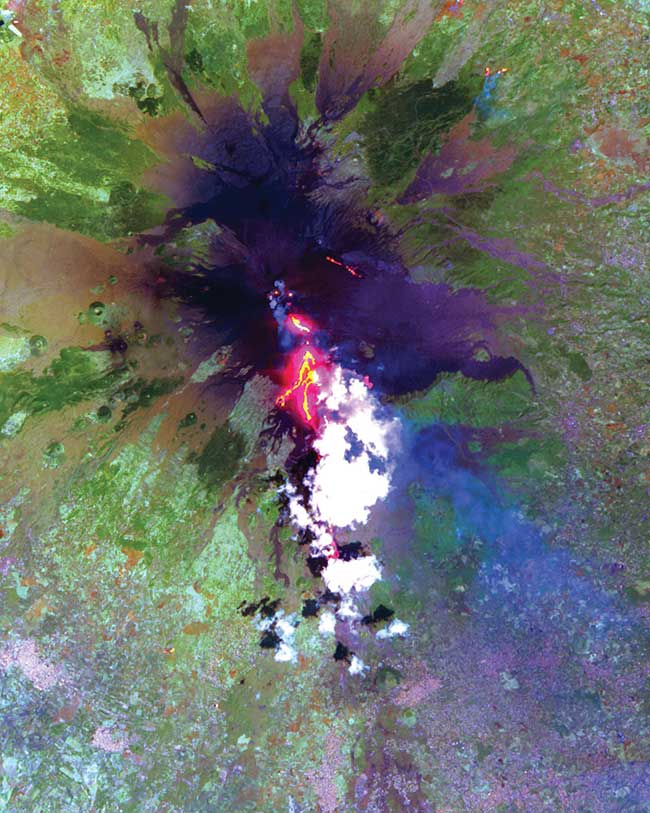The eruption of Mount St. Helens in Washington in 1980 took many by surprise, considering the volcano hadn’t been active in more than a century. The same held true in Chile after the Chaitén volcano erupted in 2008 following thousands of years of dormancy. Emphasis is often put on predicting the onset of the eruptions of these sleeping giants. But researchers from the University of Hawai’i at Manoa (UGM) School of Ocean and Earth Science and Technology (SOEST) say that knowing when an effusive eruption will end is just as important as the onset in terms of reducing hazards.

This image was acquired by NASA’s Terra satellite in July 2011 and shows advancing lava flows on the southern flank of Mt. Etna above the town of Nicolosi in Sicily, Italy, which is potentially threatened if the eruption increases in magnitude. Also visible are glowing summit craters above the main lava flows, and a small fissure eruption. The bright puffy clouds were formed from water vapor released during the eruption. Courtesy of NASA/GSFC/METI/ERSDAC/JAROS, and U.S./Japan ASTER Science Team.
Using thermal infrared remote sensing data acquired from NASA’s Moderate Resolution Imaging Spectroradiometer (MODIS) aboard the Terra and Aqua satellites, the UGM researchers set out to test a hypothesis first published in 1981 that detailed how lava flow rate changes during a volcanic eruption. The model predicted that once a lava flow-forming eruption begins, the rate at which lava exits the vent quickly rises to a peak. It then reduces to zero over a much longer period of time and the eruption ends.
Estelle Bonney, a graduate student in the SOEST Department of Geology and Geophysics at UGM told Photonics Media that the group studied the time-averaged discharge rate (TADR) time series of 104 eruptions in 34 volcanoes over the last 15 years.
“MODIS makes measurements in 36 spectral bands from visible to thermal infrared (TIR) wavelengths, and for lava flow studies we are interested in the latter to measure thermal emission,” said Bonney. “The system has been monitoring every square kilometer of Earth’s surface up to four times per day, every day, since 2000.”
Although MODIS has a spatial resolution of 1 km² at the lowest point, its temporal resolution makes it the most effective tool to estimate lava discharge rates given the temporal variability. Thirty-two of the 34 volcanoes studied followed the pattern and proved the group’s hypothesis based on the MODIS-derived maximum lava discharge rate and a decay constant.
MODIS infrared measurements allowed Bonney and fellow researchers to detect and measure the thermal emission from erupting volcanoes.
“Via estimating how the rate of lava discharge varies over time, we discovered that infrared satellite data could be used to predict when lava flow-forming eruptions will end,” said Bonney.
In the future, the researchers predict that remote-sensing technology will improve both temporal and spatial resolution, which will allow them to develop near real-time discharge rate retrievals at any volcano around the globe. This could potentially become a useful tool for predicting the end of lava flow-forming eruptions.